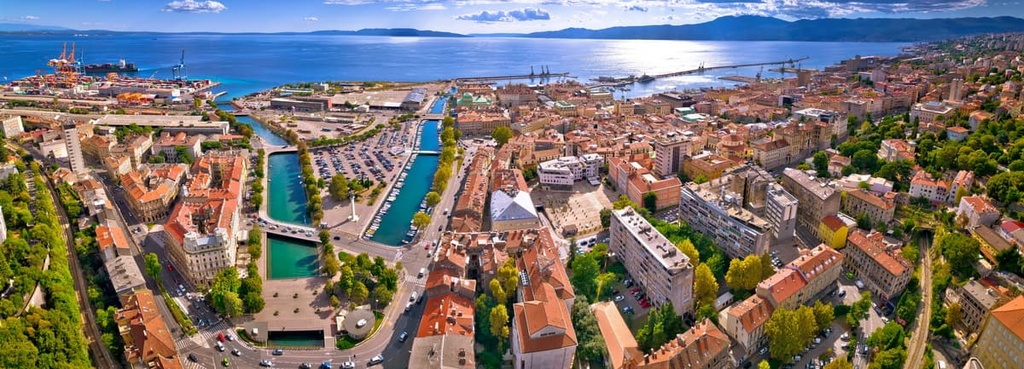Get PeakVisor App
Sign In
Search by GPS coordinates
- Latitude
- ° ' ''
- Longitude
- ° ' ''
- Units of Length

Yes
Cancel
Share ×

Scan the QR code and open PeakVisor on your phone
❤ Wishlist ×
Choose
Delete
Risnjak National Park is a protected area located in the Gorski Kotar region of northwestern Croatia. It encompasses the massifs of Risnjak and Snježnik as well as the headwaters of the Kupa River. There are 11 named mountains in Risnjak National Park, the highest and the most prominent of which is Veliki Risnjak (1,528 m/5,013 ft).
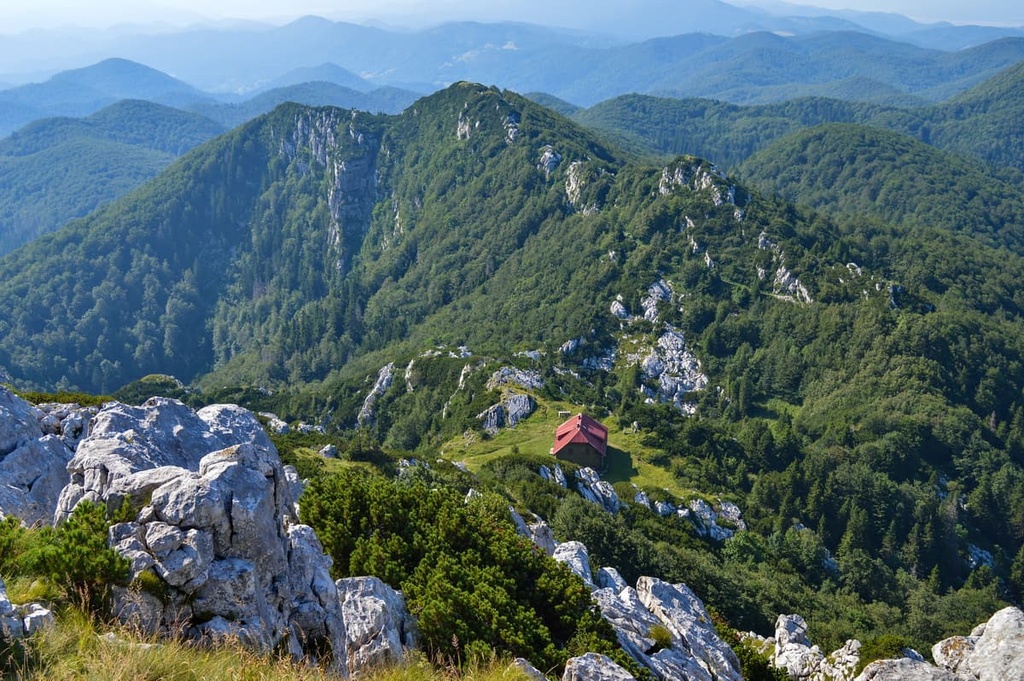
Risnjak National Park is located in the Gorski Kotar region of Croatia. The closest small towns to Risnjak National Park are Delnice, Čabar, and Bakar. Locals named the Risnjak National Park (Nacionalni park Risnjak) after the often-seen lynx. In Croatian, lynx is translated to ris. Therefore, Risnjak literally ‘means country of the lynx.’
The Gorski Kotar region that contains the park is a woodland full of lush forests and low elevation hills. Risnjak serves as a border between Gorski Kotar and the Adriatic Sea. The sea is situated only 15 km (9 mi) away from the top of Veliki Risnjak (1,528 m/5,013 ft). This means that the park is home to a diversity of both flora and fauna.
Risnjak National Park covers 63.5 sq. km (39 sq. mi) of surface area. The park is bordered to the north by the international border between Slovenia and Croatia and to the south by the seaside and the city of Rijeka. On the eastern side of the park lies the village of Crni Lug while the remainder of the Snježnik massif is located to the west.
The park protects three national phenomena, namely two massifs and the headwaters of one major river. These include:

The Risnjak massif serves as a natural border between Croatia’s seaside and its continental plains. Snježnik massif also forms part of this border, however, it extends further across the. Slovenia-Croatia border. In Slovenia, they call the massif Veliki Snežnik and it has a maximum elevation of 1,796 m/5,892 ft.
Additionally, the Risnjak and Snježnik massifs are considered part of the Dinaric Alps, which aren’t technically part of the European Alps despite their name. However, this park is part of the territory that connects and merges the Dinarides and Alps.
This connection has served as a gateway for different species of flora and fauna. In fact, over millennia, many wildlife species have migrated between the two alpine massifs and populated Risnjak as a result of its mild climate and dense woodlands.
The Risnjak massif, together with the Risnjak National Park, forms a natural border between the mountains of the Balkan Peninsula and the Alps. Therefore, its relief and geological origin are unique from that of the Alps and many of the other surrounding ranges.
The first geological formations that occurred in the park were rocks that were created during the Paleozoic. These rocks are of carbonate origin and they formed until the Kvartar period.
Carbonate rocks, specifically limestone and dolomite, are predominant in Risnjak National Park. Researchers found rocks from the Paleozoic in the Krašičevica and part of the Kupa Valley.
Additionally, there are rocks that date back to the Triassic around Leska, Bela Vodica and Biljevina. At the same time, younger Triassic and Jurassic limestone rocks are located at the higher elevations of Risnjak and Snježnik.
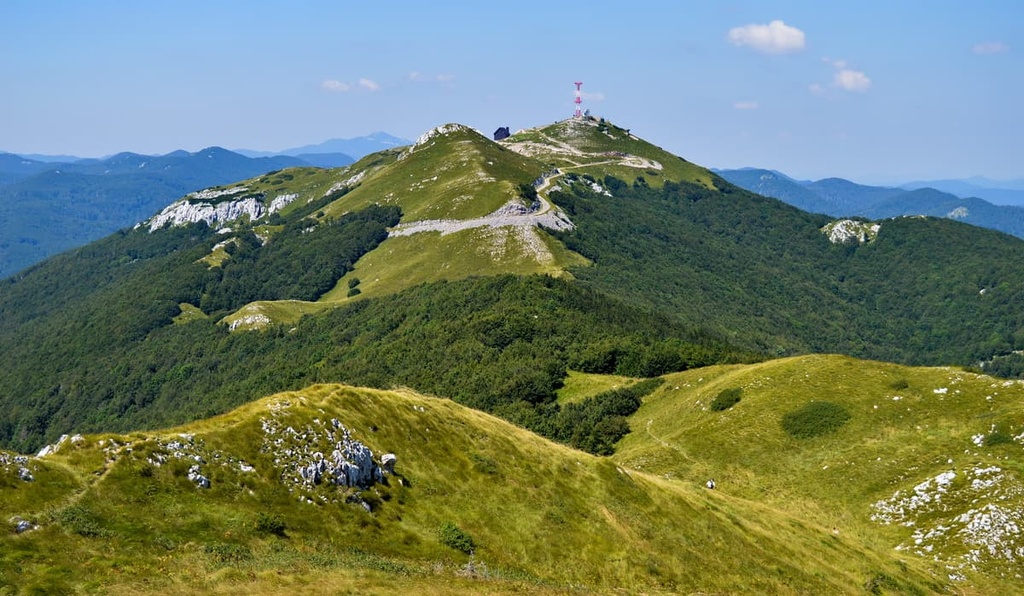
Constant chemical and physical dissolution of limestone rocks in water is what formed the karst terrain of the Dinaric Alps that we see today. The most common karst forms found here are karst fields, caves, pits, and barren rock fields.
That said, water is generally scarce here. Only a few springs are accessible throughout the year in the southeastern side of the Risnjak National Park. The peaks of Risnjak can hold snow for up to five months a year. Here, the snow slowly thaws and feeds water sources in lower elevations. There are no permanent water sources on Risnjak.
The biggest karst water spring in Croatia is the River Kupa. The Kupa begins high up on the Snježnik massif where it is surrounded by limestone rocks and forms a beautiful spring that’s well worth checking out if you’re in the region.
The Risnjak massif mostly consists of limestone and dolomite rocks. The peaks of Risnjak, just like the rest of the mountains, in the region are covered by karst formations and thick forests.
Even though the Adriatic Sea is only 15 km (9 mi) away, the mountain is overgrown with thick vegetation. This vegetation offers refuge to numerous animal and plant species that are characteristic of the region’s alpine, continental, and Mediterranean climates.
Risnjak National Park lies on the divide between the watersheds of the Adriatic and the Black seas. This means part of its waters flow to the nearest Adriatic Sea while the other half, like the Kupa River, pour into the Black Sea.
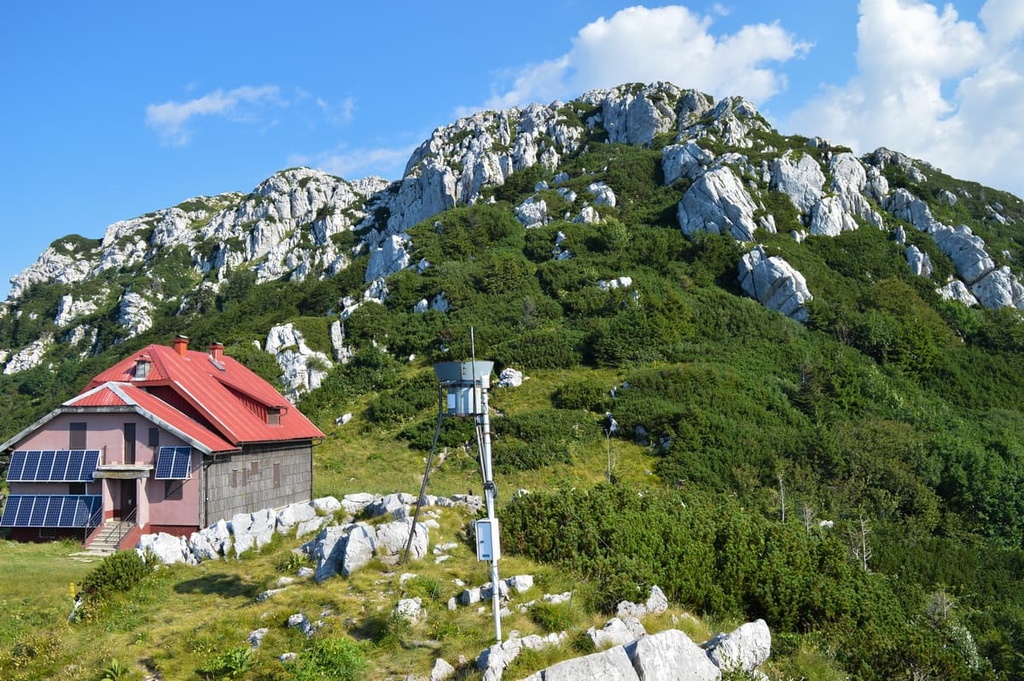
The highest peaks of Risnjak National Park include:
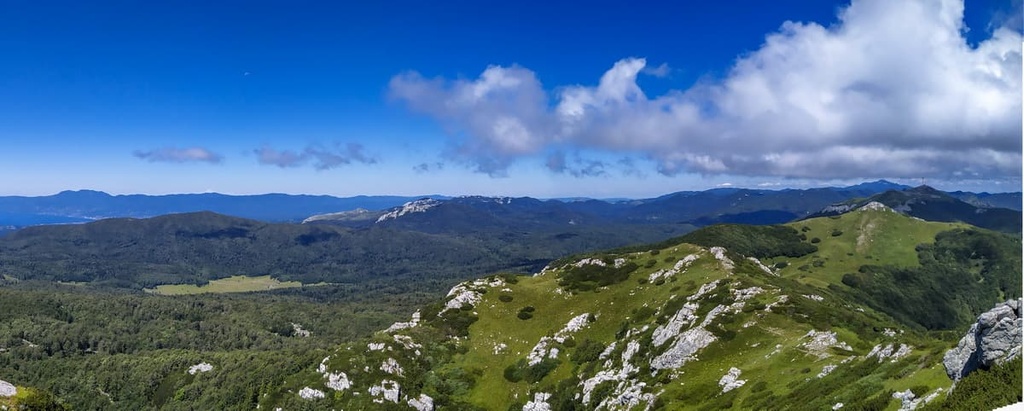
The Snježnik massif can either be considered an extension of the Julian Alps or the starting point for the Dinaric Alps. Its highest elevation, Veliki Snežnik (1,796 m/5,892 ft), is located on the Slovenian side of the border. The southernmost lowest elevations of the massif extend into Croatia and into Risnjak National Park.
The karst plateau of Snježnik has a surface area of 85 sq. km (52 sq. mi). The main peak of the massif, alongside the rest of the plateau, are popular hiking destinations. There, one can visit the Koča Draga Karolina (lit. Drago Karolin Hut) and climb the Veliki Snežnik (1,796 m/5,892 ft) peak.
Despite the fact that Risnjak National Park covers only a small area of 63.5 sq. km (39 sq. mi), it is a biodiverse haven for endemic and rare animal and plant species.
The diversity of species in Risnjak National Park developed as a result of the region’s favorable climate. The first botanist to research the park’s flora was Joseph Standler in 1825. Many other notable botanists soon followed, however, Josip Schlosser is perhaps the most notable of these researchers.
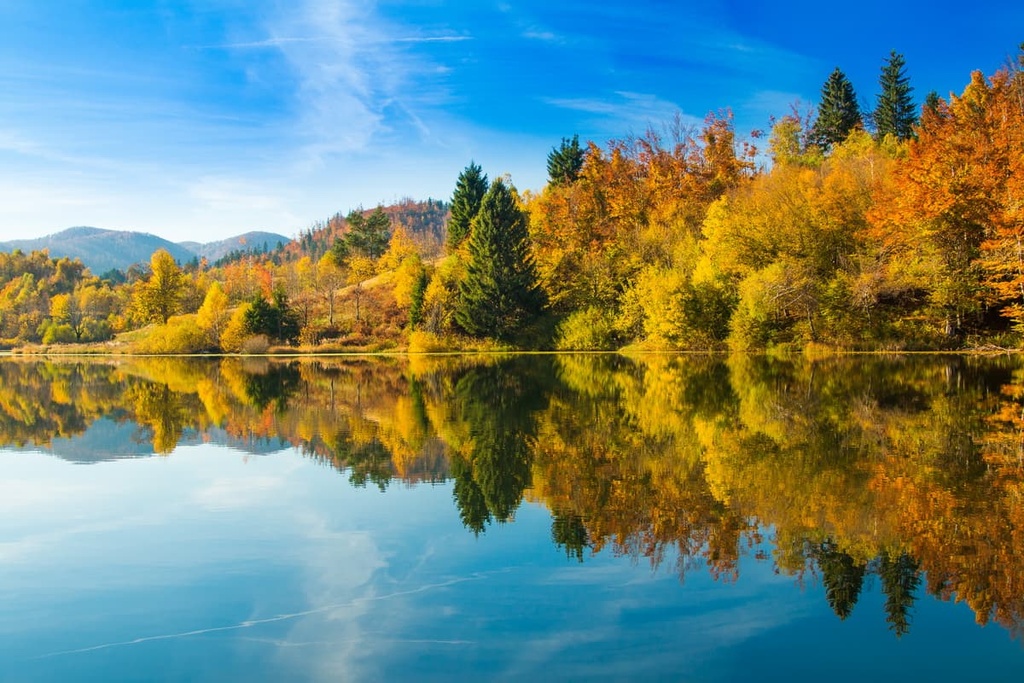
Schlosser published numerous works on the park’s flora and he studied almost all plant species in the region. In 1932, he built a mountain hut below the peak of Risnjak. The hut still stands to this day, and is known as the Schlosser Mountain Hut.
Another notable botanist contributed to the park’s protection. His name is Ivo Horvat, and he was among the first to suggest to the Croatian government that they ought to establish the Risnjak region as a protected area. In 1949, the area was declared a national park.
When looking at the park’s flora, the first thing one sees is its high species count. An estimated 1,148 species of plants thrive in the park, though only 80 percent or so have been fully documented. This means there is still a lot more work to be done for future biologists and researchers.
There are also a number of endangered plant species found in Risnjak National Park. These endangered floral species include edelweiss, mountain avens, alpine snowbell, and hairy alpine rose.

Fauna in the Risnjak National Park includes all three big European predators, namely brown bears (Ursus arctos), wolves, and lynx. There are also 114 bird species found in Risnjak as well as dozens of butterfly species. The butterflies are easiest to see in the Kupa Valley, which is also partially known as the “Valley of Butterflies” since they are so common there.
The ecosystems found in the park include:
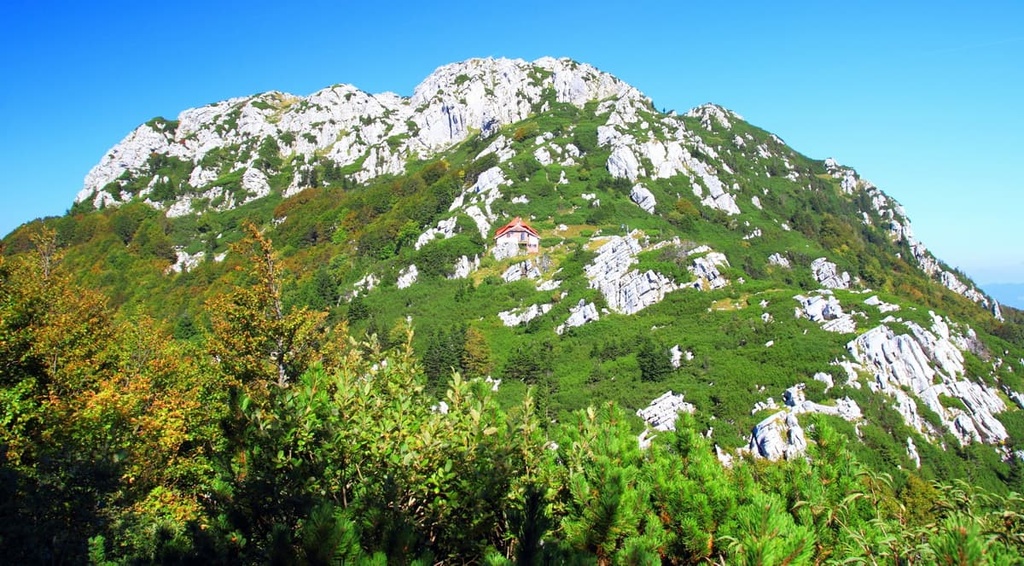
Risnjak serves as a type of natural border between the country’s seaside and continental climates. With only 15 km (9 mi) of distance between the Adriatic Sea and the peak of Risnjak, the park is a place where continental, Mediterranean, and Alpine climates meet.
The summers in the mountain are pleasant, with daily temperatures rising to around 20°C (68°F). The evenings are colder in the summer but still pleasant. Frost and snow are sights often seen on top of Risnjak in the winter. The park also receives a decent amount of precipitation each year.
When visiting, make sure to check the weather forecast and bring your rain jacket with you. Wind and rain are not uncommon in the afternoon, even if the day starts off as sunny.
The Risnjak area has always served as a type of border, not just climatically and biologically, but also with regards to communities and cultures. Today, Risnjak National Park lies on the border between Slovenia and Croatia. As a result, the range has long served as a border between the cultures of the coast and the interior.
The development of the Gorski Kotar region largely depends on its communication routes. The local Illyrian tribe called the Iapodes as well as the Romans were the first to build roads here. Until this day, there is still a road named the Roman road in the Risnjak area.
An interesting archeological find in the area is that of the Srebrena Vrata (lit. Silver Door), which was carved out of a rock face during Roman times. The goal was to make the road to Risnjak much shorter. According to legend, this undertaking took as much silver as there was rock to pay for the carving of the door.
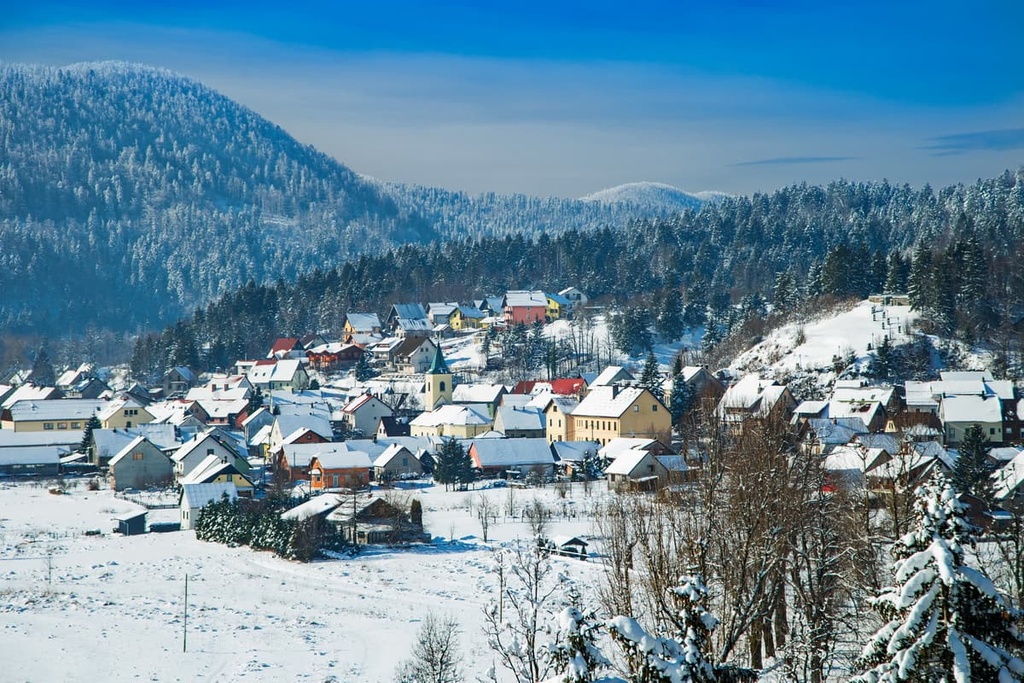
Life in the Risnjak massif region was quiet during the medieval period, and the same could be said for modern times, too. The first researchers in the park stumbled upon thick forests full of wildlife, which implies that human settlements have long been scarce in the region.
Nevertheless, the Risnjak region still had a crucial role to play in trade. Traders from all around Europe passed through Risnjak and its villages to get to Southeastern Europe. Also, maritime traders from Rijeka took advantage of the roads in Gorski Kotar in order to ship their goods inland.
That said, the traditional way of life on the mountain meant living from the forests and fields. Locals practiced animal husbandry and they grew crops. They built their homes out of a stone base with wooden roofs. But what they had in abundance was wood, thanks to the region’s dense forests, and that’s why the area is known for its tradition of woodworking.
The cultural heritage of the area is represented by wooden shingles called Šindra. This is a traditional craft and it has long been practiced to produce the shingles that cover the roofs of traditional houses. Today, only a few traditional farmer households remain. Most of the locals live in small villages, and only 60 people continue to live in the park to this day.
As was mentioned previously, some of the first people to enter the wilderness of Risnjak were botanists from all around Europe. The first of these botanists was Joseph Standler in 1825 and he was followed about a century later by Josip Schlosser.
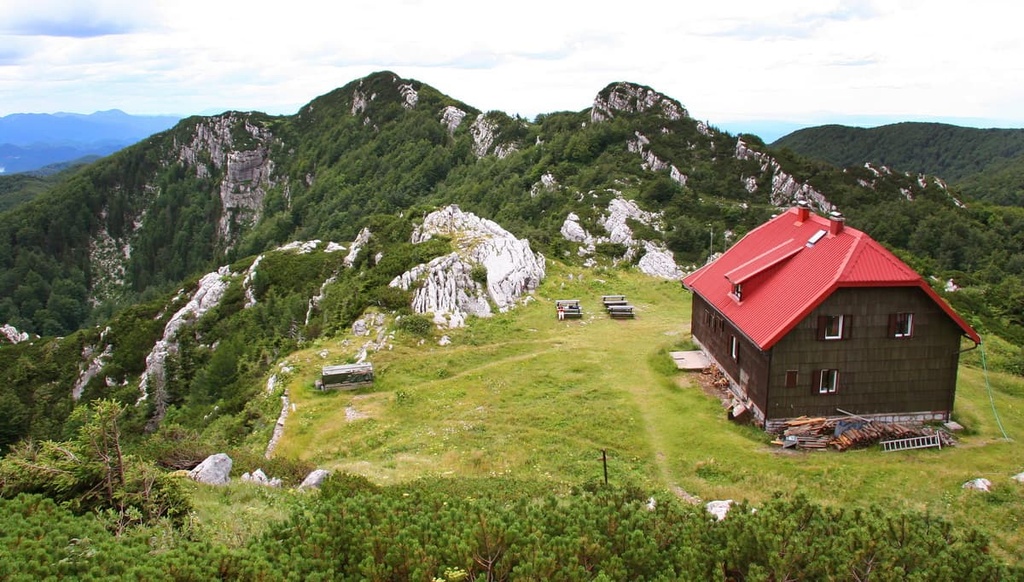
After Schlosser built his mountain hut, Schlosserov dom, in 1932, the Risnjak massif was officially open to visitors. The Rijeka Alpine Club undertook the first organized hike on the Risnjak by trekking from Crni Lug to Veliki Risnjak (1,528 m/5,013 ft).
Soon afterward, Risnjak was proclaimed a protected area. This was in 1949, when the park had a surface area of only 36 sq. km (22 sq. mi) and was designed to protect only the ridge of Risnjak. The government put the park under more strict protection in 1956. Finally, in 1997, the Croatian government increased the area to its current size and borders.
As one of Croatia’s most visited national parks, Risnjak National Park is a true natural beauty. Its deep green forests and rocky peaks are a sight to behold. Risnjak has something to offer for any kind of hiker, regardless of whether you want to enjoy nature or test your endurance.
Here are some of the best trails to check out during your next visit to the park.
Kupa Spring is the deepest and biggest karst water source in Croatia. One can easily reach it via a maintained trail from either Hrvatsko or Razloge. The spring features a beautiful turquoise pool full of cold water.
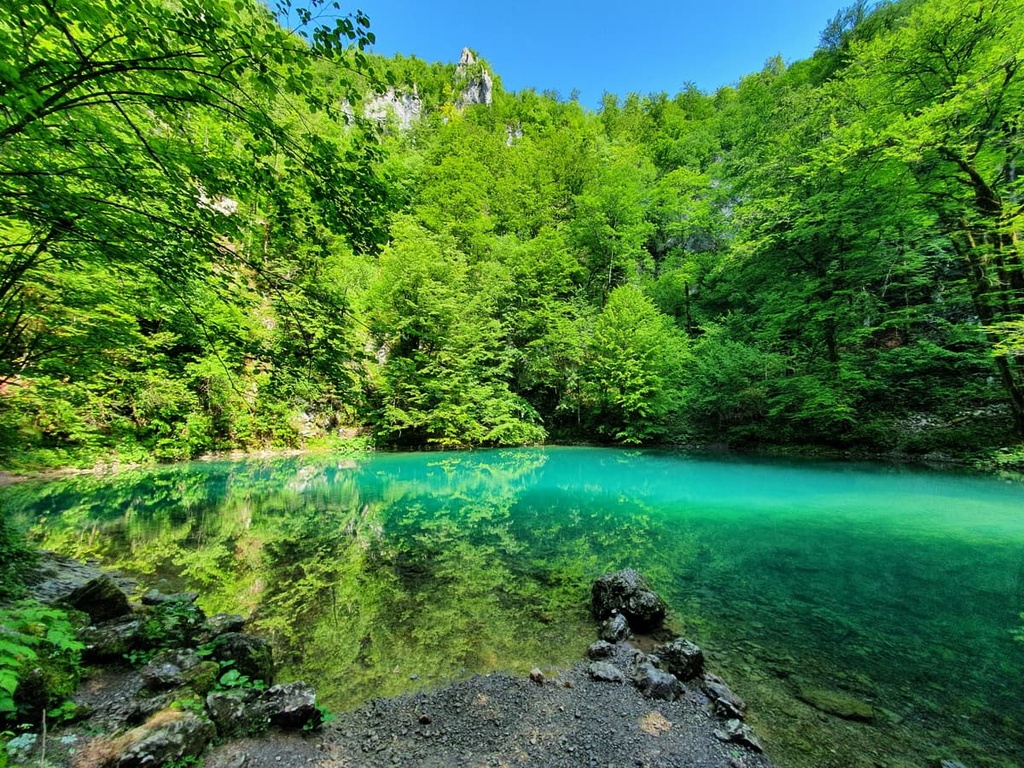
One starting point for this hike is Razloge, a village that you can reach by car through Crni Lug. From here, the trail is casual, and it takes around half an hour to travel the 2 km (1.2 mi) to the spring. The elevation gain on this trail is around 200 m (650 ft).
Or, if you want to reach the Kupa River through Hrvatsko on the Slovenian-Croatian border, the trail will take about 1.5 hours to walk as it is about 5 km (3 mi). However, the trail has almost no elevation change and is a nice casual walk for the whole family to enjoy.
Veliki Risnjak (1,528 m/5,013 ft) is the highest peak in Risnjak National Park. Therefore, it is the most popular hiking destination here. Most visitors take the Horvat’s Trail, leading from Bijela Vodica in Crni Lug to the peak of Veliki Risnjak. After a scenic hike through forests for around 3 km (1.8 mi), one reaches the mountain plateau.
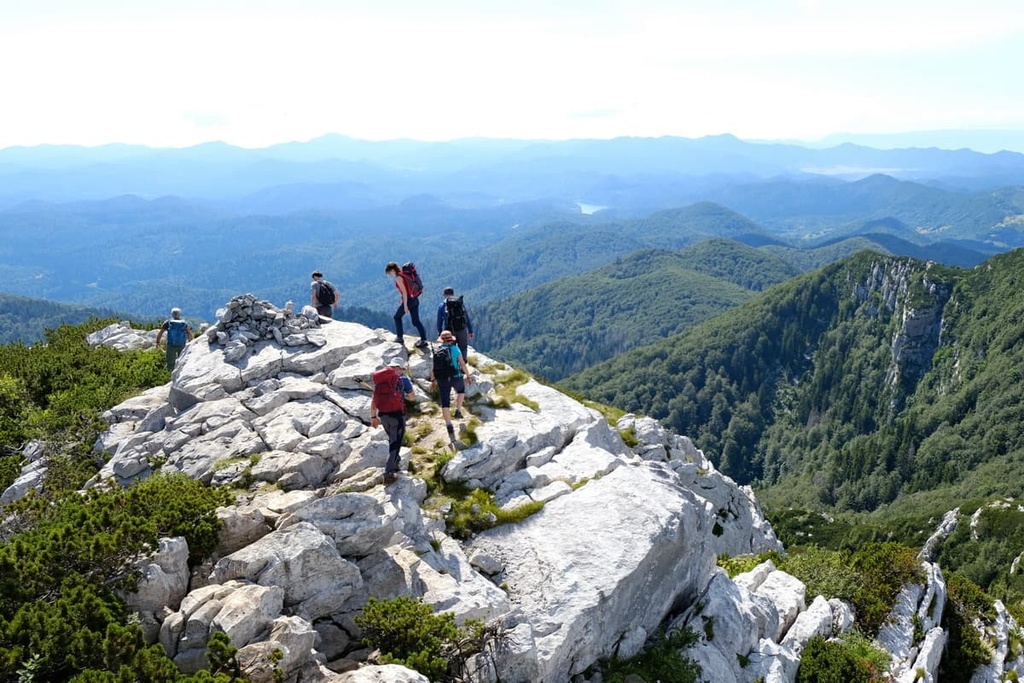
Soon, afterward, you’ll make your way to the famous Josip Schlosser Mountain Hut. On the top of Veliki Risnjak, you will enjoy a scenic view that includes the Adriatic Sea, the island of Krk, the city Rijeka, as well as nearby mountains like Snježnik, Učka, and Velebit.
This is an intermediate to strenuous hike with an elevation gain of 800 m (2,624 ft) and a length of 8 km (5 mi).
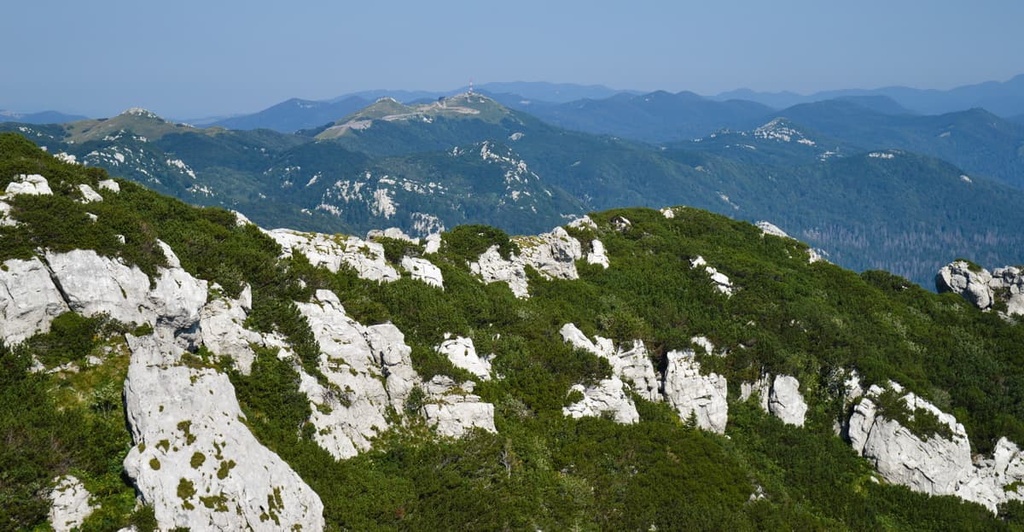
Snježnik is the perfect destination for family hikes. Therefore, if you have time to visit both Risnjak and Snježnik, it’s a great idea to do so.
The trail to Snježnik (1,505 m/4,938 ft) starts at Platak Hut and passes through a beautiful mountain meadow called Lazac, which you will enjoy because of its colorful flowers. The hike is intermediate in difficulty and has an elevation difference of around 500 m (1,640 ft). Most people take about two hours to complete this hike.
Risnjak National Park is located in northwestern Croatia. One can reach it via Zagreb, Ljubljana, Rijeka, and Karlovac through the Crni Lug entrance. It is one of the most commonly visited national parks in Croatia due to its proximity to some of the country’s largest cities.
Here are some of the best cities to check out during your visit to Risnjak National Park.
Rijeka is the closest city to the Risnjak National Park. While small towns like Delnice, Čabar, and Bakar only offer cottage, village, and mountain hut accommodation, Rijeka has much more to offer.
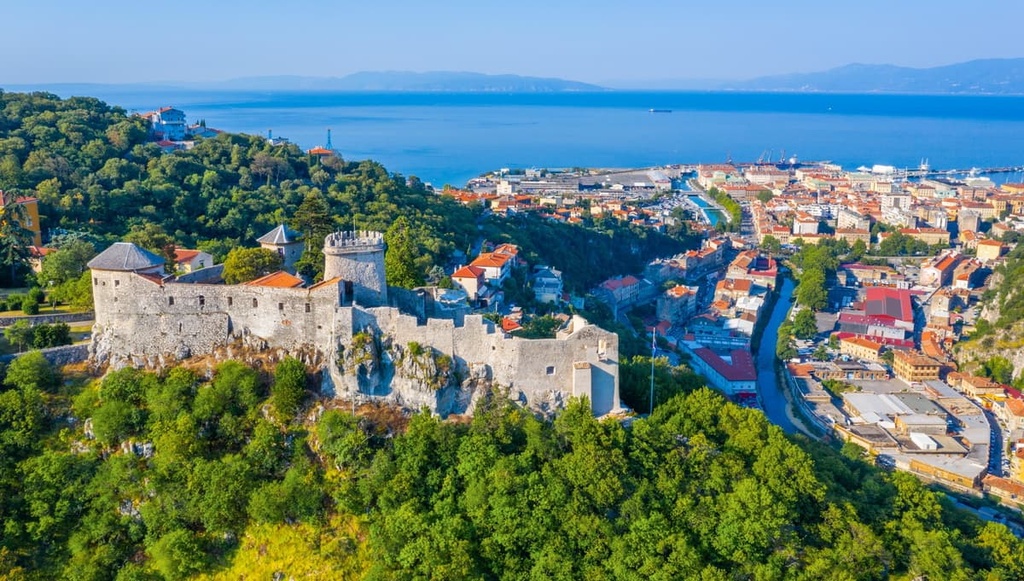
You can travel to Rijeka via car, bus, train, boat, catamaran, or airplane. Also, you can book a stay in a hotel, hostel, inn, apartments, bed and breakfast, campsite, or any other accommodation type you prefer while in the city.
Rijeka is a seaside city that takes advantage of its position in the Rijeka Bay on the Adriatic Sea. The local industry focuses on trade and shipbuilding. Visitors can see the typical architecture of numerous periods of European history in the city since Rijeka was once ruled over by Italy, Austria-Hungary, Yugoslavia, and now Croatia.
Karlovac is a small city situated in northern Croatia that is home to 55,000 inhabitants. It is easy to reach since it is on the Zagreb-Rijeka highway and railway line. Karlovac is a tourist-friendly city with numerous hotels, inns, apartments, and campsites for rent.
When visiting Karlovac, some of the best attractions include the city’s large freshwater aquarium, Aquatica, and Dubovac Castle.
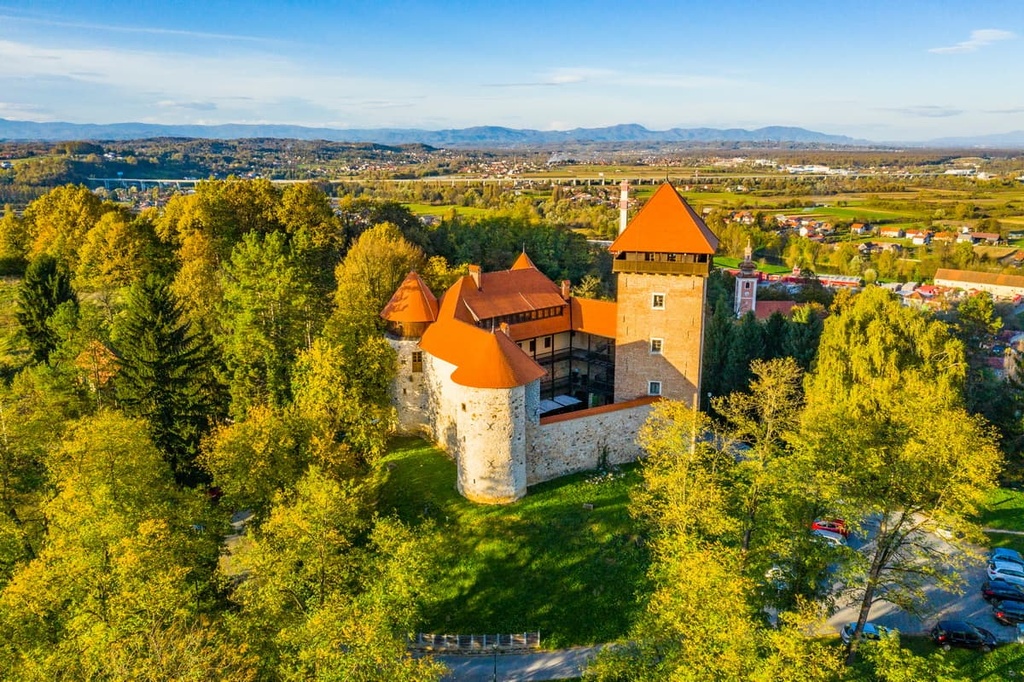
With a population of 800,000 inhabitants and beautiful Habsburg architecture, Zagreb is both the capital of Croatia and one of its most popular tourist destinations.
The city was founded in the thirteenth century, which is when the Zagreb Gothic Cathedral was built. Just like one would expect, Zagreb has all the accommodation options one could think of, from hotels to campsites. It is accessible via air, rail and road transport.
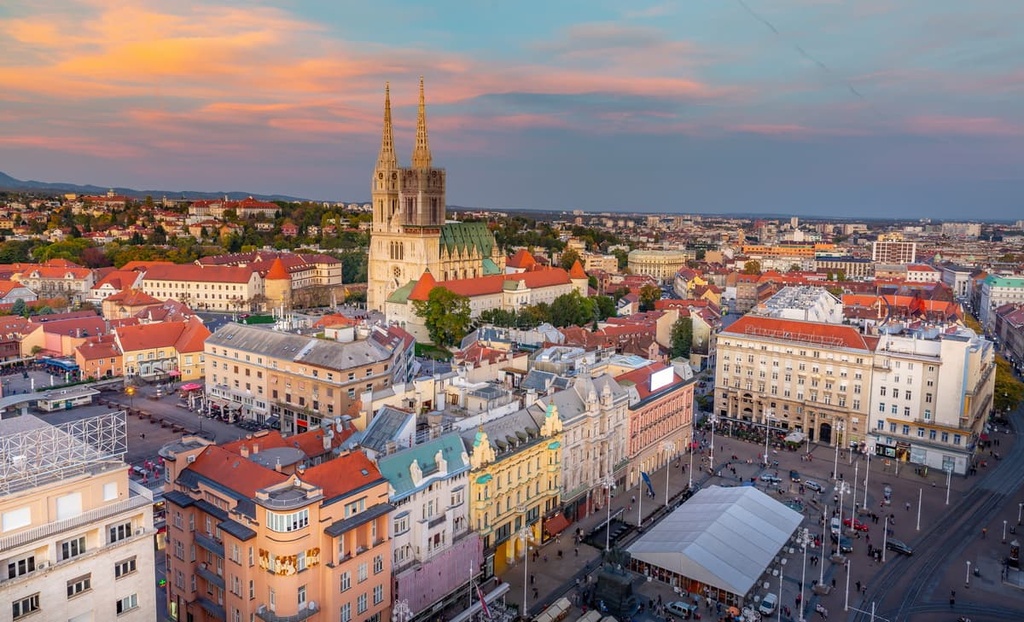
Explore Risnjak National Park with the PeakVisor 3D Map and identify its summits.


